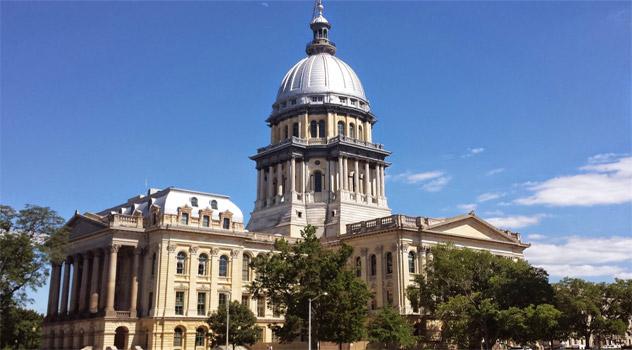
Recently there has been a great deal of discussion about the Local Government Distributive Fund (LGDF) and the State’s attempts at taking a larger piece of it. But why do municipalities believe they are entitled to it? What was the original agreement that makes municipalities fight so fiercely for those revenues? And how has this changed since its creation? This article will answer those questions and more as we look into the history of LGDF.
Communities throughout Illinois have utilized the LGDF for nearly 50 years in lieu of a higher tax revenue source from their residents. The roots of the Local Government Distributive Fund took shape in 1969 when Chicago Mayor Richard J. Daley and mayors from across Illinois agreed to support Governor Richard Ogilvie’s proposed income tax initiative on the condition that the municipalities get a share of the income tax. In exchange, they would not institute local income taxes.
It was a grand bargain that all involved hoped would provide a stable municipal revenue source via the LGDF for many years and decades to come. Upon enactment, municipalities began to receive 1/12th of monthly individual and corporate income tax revenues, but why was that decided?
A primary driver for the LGDF in 1969 was the partnership between the State of Illinois and local municipalities to help support core services and keep local taxes low. Funds from the LGDF were earmarked “for the general welfare of the people of the State of Illinois”. They also help fund core municipal services such as police, fire, public safety, roads, sidewalks, water and sewer, snowplowing and public works.
The institution of the first Illinois income tax was risky politically for all involved at the time, but Governor Ogilvie and the municipalities agreed to the compromise with the goal of stabilizing revenue sources and modernizing state government. The introduction of state income tax proved to be particularly unpopular with the electorate, and Ogilvie lost a close election to Daniel Walker in 1972, ending his career in elective office.
However, the LGDF revenue has continued to provide tremendous value in the decades since for local taxpayers, helping fund services used by nearly every resident. Municipal governments have been able to utilize their LGDF share to balance their budgets and continue to fund core services without relying on additional property taxes from their residents and businesses.
The income tax rate, along with the municipal LGDF share, has changed over the ensuing years. A 1970 law adjusted the LGDF to 1/12th of net revenue from income tax, which included income tax revenue minus paid refunds. Already modifying the initial agreement just a year later would prove to be a dubious omen for the future.
LGDF revenue was increased to 9% of state income tax revenues in 1994, and to 10% of total collections in 1995. However, a 2011 temporary income tax increase, reduced the LGDF to 6% of total collections.
The contribution rate to the LGDF was cut at the time so the cash-strapped state could keep all the additional revenue raised by the temporary increase in the state income tax and the amount remitted to the municipalities would remain the same. When the income tax rates declined in January 2015, the LGDF share increased to 8% of total collections.
A provision reducing the amount of income tax revenue for the LGDF by 10% was recently included in the FY2018 State of Illinois budget. The reason given for this 10% reduction was to offset two additional payments to be made to local governments from the LGDF. According to the new agreement, the State will provide 14 LGDF distributions over the 12 months of the State’s fiscal year (7/1/17 – 6/30/18.)
The State asserts that because there are 14 payments (rather than 12 payments) over the next 12 months, local governments will be “held harmless” in terms of total revenue, if not see a slight increase. However, these accelerated payments only eliminate the current two-month lag time between the receipt of the funds by the State and the disbursement of those funds to municipalities.
The outcome is local governments won’t receive additional revenue (only revenue that is already due to them) and will most likely experience a 10% decrease in their portion of LGDF revenue.
In addition, regardless of the lag time, most governments continue to record LGDF revenues in the month in which the revenue should have been received. Thus, unless a local government records LGDF payments on a cash basis (in the month cash is actually received), there will still only be 12 months of revenue. Once again, demonstrating that local governments will not recognize additional revenue.
Unfortunately, this projected decrease in LGDF revenues has continued to erode the original purpose of the Local Government Distributive Fund, which was to equitably share and agreed upon portion of tax revenue between the State and local communities to avoid the need for local tax increases. The battle will continue into the future as municipalities strive to protect what is rightfully theirs from the bargain stuck in 1969. As hard as they battle, municipalities may have to begin planning for a future in which they must get their revenues from sources outside the State’s control.
But before local governments take that step, they should ensure they are receiving the maximum amount form their current revenue sources. That’s where Azavar can help.
We specialize in uncovering missing revenues and identifying untapped opportunities for cost savings that can make all the difference to the budget crunch in your municipal finances. Azavar Government Solutions provides comprehensive audit services that draw on our specialist expertise and cutting-edge technology to recover millions of dollars in unpaid revenue – based on collection errors that have sometimes gone back decades.
As your local government prepares continued fluctuations and lower LGDF revenue, it’s time to consider maximizing your revenue sources. Contact us today to learn how we can you make sure that your municipality is receiving every penny it is due.



